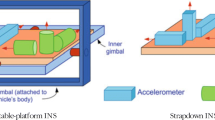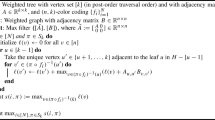Abstract
The coordinate frame transformation (CFT) problem in geodesy is typically solved by a stepwise approach which entails both inverse and forward treatment of the available data. The unknown transformation parameters are first estimated on the basis of common points given in both frames, and subsequently they are used for transforming the coordinates of other (new) points from their initial frame to the desired target frame. Such an approach, despite its rational reasoning, does not provide the optimal accuracy for the transformed coordinates as it overlooks the stochastic correlation (which often exists) between the common and the new points in the initial frame. In this paper we present a single-step least squares approach for the rigorous solution of the CFT problem that takes into account both the intra-frame and inter-frame coordinate covariances in the available data. The optimal estimators for the transformed coordinates are derived in closed form and they involve appropriate corrections to the standard estimators of the stepwise approach. Their practical significance is evaluated through numerical experiments with the 3D Helmert transformation model and real coordinate sets obtained from weekly combined solutions of the EUREF Permanent Network. Our results show that the difference between the standard approach and the optimal approach can become significant since the magnitude of the aforementioned corrections remains well above the statistical accuracy of the transformation results that are obtained by the standard (stepwise) solution.




Similar content being viewed by others
Notes
According to this theorem (Koch 1999, pp. 156–158) the BLUE of a linear function \(\mathbf{q}=\mathbf{Q} \varvec{\uptheta }+\mathbf{c}\) of a parameter vector is given by \({\hat{\mathbf{q}}}=\mathbf{Q} {\hat{\varvec{\uptheta }}}+\mathbf{c}\), where \({\hat{\varvec{\uptheta }}}\) is the BLUE of the parameter vector while Q and c are fixed (deterministic) quantities. The transformed coordinates in Eq. (17), on the other hand, have the form \({\hat{\mathbf{q}}}=\mathbf{Q} {\hat{\varvec{\uptheta }}}+\mathbf{c'}\), where \(\mathbf{c'}\) corresponds to an observed vector which is correlated with the parameter estimator.
These identities are directly obtained from the general matrix property (e.g. Blewitt 1998, p. 248) \(({\varvec{\Lambda }}_1 \pm {\varvec{\Lambda }}_{12} {\varvec{\Lambda }}_2^{-1} {\varvec{\Lambda }}_{12}^T)^{-1}={\varvec{\Lambda }}_1^{-1} \mp {\varvec{\Lambda }}_1^{-1} {\varvec{\Lambda }}_{12}{({\varvec{\Lambda }}_2 \pm {\varvec{\Lambda }}_{12}^T {\varvec{\Lambda }}_1^{-1} {\varvec{\Lambda }}_{12})}^{-1}{\varvec{\Lambda }}_{12}^T {\varvec{ \Lambda }}_1^{-1}\) by substituting \({\varvec{\Lambda }}_1 =\mathbf{A},\,{\varvec{\Lambda }}_2^{-1} =\mathbf{B}\) and \({\varvec{\Lambda }}_{12} ={\varvec{\Lambda }}_{12}^T =\mathbf{I}\).
References
Altamimi Z (2003) Discussion on how to express a regional GPS solution in the ITRF. EUREF Publication No. 12, Verlag des Bundesamtes für Kartographie und Geodäsie, Frankfurt am Main, pp 162–167
Altamimi Z, Boucher C, Sillard P (2002) New trends for the realization of the international terrestrial reference system. Adv Space Res 30:175–184
Bevis M, Brown A (2014) Trajectory models and reference frames for crustal motion geodesy. J Geod 88:283–311
Blewitt G (1998) GPS data processing methodology. In: Teunissen PJG, Kleusberg A (eds) GPS for Geodesy, 2nd edition. Springer, Berlin, pp 231–270
Gibbs B (2011) Advanced Kalman filtering, least-squares and modelling: a practical handbook. Wiley, New York
Koch K-R (1999) Parameter estimation and hypothesis testing in linear models, 2nd edition. Springer, Berlin
Leick A, van Gelder BHW (1975) On similarity transformations and geodetic network distortions based on Doppler satellite observations. Technical Report No. 235, Department of Geodetic Science, Ohio State University, Columbus, Ohio
Mahboub V (2012) On weighted total least squares for geodetic transformation. J Geod 86:359–367
Petit G, Luzum B (eds) (2010) Internation earth rotation and reference systems service (IERS) conventions. IERS Technical Note No. 36, Verlag des Bundesamts fur Kartographie und Geodäsie, Frankfurt am Main
Schaffrin B, Wieser A (2008) On weighted total least squares adjustment for linear regression. J Geod 82:415–421
Schwarz K-P (1974) Combination of spatial networks using an estimated covariance matrix. Bull Geod 112(1):171–186
Sillard P, Boucher C (2001) A review of algebraic constraints in terrestrial reference frame datum definition. J Geod 75:63–73
Soler T (1998) A compendium of transformation formulae useful for GPS work. J Geod 72:482–490
Tregoning P, van Dam T (2005) Effects of atmospheric pressure loading and seven-parameter transformations on estimates of geocenter motion and station heights from space geodetic observations. J Geoph Res 110:B03408. doi:10.1029/2004JB003334
Author information
Authors and Affiliations
Corresponding author
Appendix
Appendix
The BLUE estimators related to the solution of the geodetic CFT problem are analytically derived in this appendix. Our proof scheme considers the most general case of the problem by taking into account both the intra-frame and inter-frame covariances in the coordinate datasets. The optimal transformation formulae given in Sect. 3 [see e.g. Eq. (39)] stem directly as special cases of the following derivations.
Let us first express the system of observation equations from Eqs. (55)–(58) in the equivalent algebraic form
Using block-matrix notation the above system can be written as

or, in a more compact form
The meaning of all auxiliary terms in the last equation is deduced from (69). The data weight matrix that is associated with the above system has the general form
where
Using elementary covariance propagation rules, we may express the submatrices of the auxiliary cross-CV matrix \(\varvec{\Sigma }_{\varvec{\updelta }\mathbf{X},\varvec{\Xi }} \) in terms of the relationships
The weighted LS adjustment of (70) leads to the normal equations system
from which we obtain the following equations for the optimal estimators \({\hat{\varvec{\uptheta }}}\) and \({\hat{{\varvec{\upxi }}}}\)
and
Solving the last equation for \({\hat{{\varvec{\upxi }}}}\) we get
and by substituting back to (79), and after several cancelations of similar terms, we end up with the relationship
Taking into account from (71) that
we finally obtain the optimal estimate of the frame transformation parameters
Based again on (71) we have the useful formula
which can be substituted to (81), thus leading to the optimal estimate of the auxiliary vector \(\varvec{\xi }\) in terms of the expression
or, in the equivalent form
Using the covariance expressions from (75)–(77), the last equation is expressed as
and, by taking into account (72), in the equivalent form
Considering that \(\varvec{\updelta }\mathbf{X}=\mathbf{X}-\mathbf{X'}\), equation (89) can be finally reduced to the form
From the last equation we explicitly obtain the optimal estimates for the transformed coordinates from the initial frame to the target frame at the common and new points, respectively
and also the “updated” coordinates at the non-common reference points (in the target frame)
Note that the terms \({\hat{\mathbf{x}}}^{\mathrm{st}}\) and \({\hat{\mathbf{z}}}^{\mathrm{st}}\) correspond to the transformed coordinates according to the standard stepwise CFT approach [see Eq. (17)].
Rights and permissions
About this article
Cite this article
Kotsakis, C., Vatalis, A. & Sansò , F. On the importance of intra-frame and inter-frame covariances in frame transformation theory. J Geod 88, 1187–1201 (2014). https://doi.org/10.1007/s00190-014-0753-5
Received:
Accepted:
Published:
Issue Date:
DOI: https://doi.org/10.1007/s00190-014-0753-5




